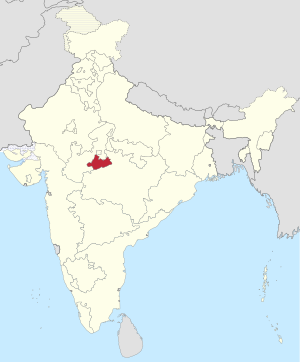Bhopal State | |||||||||
|---|---|---|---|---|---|---|---|---|---|
Former State 1949–1956 | |||||||||
| Etymology: from Bhojpal or Bhoj's dam [1] | |||||||||
 Location of Bhopal State in India | |||||||||
| Country | India | ||||||||
| Region | Central India | ||||||||
| Before was | Bhopal State | ||||||||
| Formation | 1 June 1949 | ||||||||
| Admission to union | 1 June 1949 | ||||||||
| Dissolution | 1956 (by States Reorganisation Act, 1956) | ||||||||
| Capital and largest city | Bhopal | ||||||||
| Government | |||||||||
| • Chief minister | |||||||||
• 20 March 1952 – 31 October 1956 | Shankar Dayal Sharma (First and Last) | ||||||||
| Area | |||||||||
• Total | 17,801 km2 (6,873 sq mi) | ||||||||
| Population (1931) | |||||||||
• Total | 7,300,000 | ||||||||
| Time zone | UTC+05:30 (IST) | ||||||||
| |||||||||
Bhopal was a state of India, which existed from 1949 to 1956. The state evolved out of the princely state of Bhopal, and was merged with neighbouring states to form Madhya Pradesh in 1956. Shankar Dayal Sharma of the Indian National Congress served as chief minister of Bhopal state from 1952 to 1956.